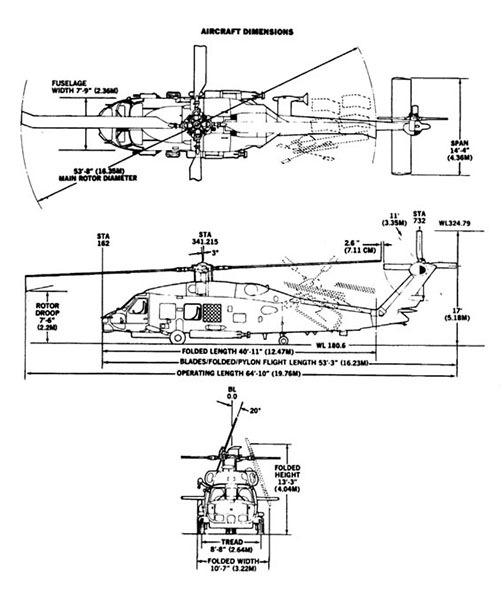Sikorsky Product History
Sikorsky S-70B
Background
Early in the 1970 decade, the U.S. Navy began planning for a new generation helicopter system to replace the Kaman SH-2 Seasprite helicopter as its platform for the Light Airborne Multi-Purpose System (LAMPS). Its primary missions would include anti-submarine warfare (ASW) and anti-surface ship targeting (ASST) while secondary missions included logistical support and search and rescue. The Navy’s intent was to take advantage of the Army’s investment in the UTTAS program by modifying the basic UTTAS design so as to create a new ASW/ASST helicopter that was to be based aboard Ticonderoga-class cruisers, Burke, Spruance and Kidd-class destroyers and Perry-class frigates
Many design changes would be required to the Army’s UTTAS for it to be able to operate in a maritime environment and to carry the unique airborne electronic sensors and weapons needed to perform the ASW and ASST missions. But in spite of the many airframe changes needed, substantial commonality with the UTTAS rotor, transmission, and flight control systems would be achieved. With this commonality, a UTTAS derivative offered lower cost and higher reliability plus it promised the long term Army commitment to its high priority utility tactical transport helicopter.
Soon after the Army selected the Sikorsky’s YUH-60A that was to become the UH-60A Black Hawk, the Navy issued requests for proposals to industry for its new generation system. Proposals were submitted in April 1977 from Boeing-Vertol, Bell, Kaman, Westland and MBB. The last three offerings were considered to be too small, being in the 12,000 lb. weight category, to perform the required missions. Boeing-Vertol proposed a version of their YUH-61A UTTAS design but with a raised rotor to help correct its vibration problems. Following a long evaluation period, the Navy made its selection in early 1978. Sikorsky’s Seahawk design was chosen because it offered significantly lower life-cycle cost as a result of parts commonality with the UH-60A. Sikorsky’s design was also selected because it was based on the proven Black Hawk aircraft and because it was the most responsive to the Navy’s specification.
The Navy authorized full-scale development in February 1978 with a contract to Sikorsky for $109.3M that included construction of five prototypes plus a ground test aircraft. First flight of Sikorsky’s YSH-60B prototype Seahawk took place in December 1979, 22 months after contract award. Following the prototype’s development and qualification period, the first production SH-60B Seahawk flew in February 1983 and entered service in 1984.
Following development of the SH-60B for outer zone protection of the carrier task force, the Navy developed the SH-60F CV for inner zone protection using a dipping sonar system. Variants of the Seahawk were also developed for search and rescue missions, the HH-60H Rescue Hawk and the HH-60J Jayhawk for the U.S. Coast Guard. These models are described below under Related Models.
Configuration Features
The most significant design changes made to the basic UH-60A Black Hawk to create the SH-60B Seahawk were in airframe, rotor, propulsion and weapons system installations. The tail landing gear was moved 13ft forward to minimize footprint on small shipboard landing areas and the main gear was changed from a dual to a single oleo design to reduce weight however this change also reduced vertical impact capability from 38 to 17 fps which was acceptable to the Navy.
External weapons pylons were added to carry torpedoes, depth charges and air-to-surface missiles. The right side pylon was able to carry an extended range fuel tank or weapons while the left pylon could carry two weapons. Larger fuel cells were installed in the fuselage to increase on-station endurance and a large radome was added below the cockpit to house the search and targeting radar. A new and lighter design concept was selected for the sonobouy launcher installed on the port side that used pneumatic power to fire the sonobouys out of the tubes instead of explosive cartridges, which was the traditional firing method.
The manual main rotor blade folding of the Black Hawk was changed to an automatic system to avoid having crewmen working at the rotor head during high sea state, hazardous conditions. A significantly lighter electrically powered blade fold system was chosen over the typical hydraulic approach. Reducing weight at the rotor was important because less weight that high up on the aircraft would result in a larger and therefore safer, critical turnover angle in the event of emergency water landing with flotation bags deployed.

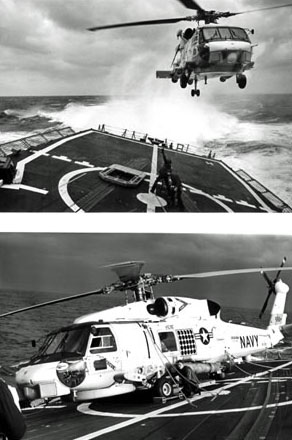
During RAST operations, the helicopter lowers a messenger cable that is connected to the ship’s haul-down cable, which is then raised and locked into the helicopter’s RAST probe. A 4000 lb. force is applied to the haul-down cable, which guides the probe into the locking beams of the Rapid Securing Device that also moves the helicopter into and out of the hanger.
The Seahawk was equipped with a 600 lb. capacity rescue hoist mounted on the right side of the fuselage, as well as with provisions to refuel while in a hover. The Navy increased the power of the Black Hawk’s original T700-GE-700 engines and to add special features to improve durability in the shipboard marine environment. That program produced the T700-GE-401 engine whose power increased to 1690HP from 1543HP for the Army’s T700-GE-700 version. Continuous development of the T700 engine resulted in many power upgrades through the years that followed its earliest applications.
To cope with this increase in engine power rating, the Seahawk transmission system was concurrently up-rated from the UH-60A main gearbox rating of 2828 HP to 3400 HP for the Seahawk. This was achieved by increasing certain gearing face widths and selectively strengthening shafting and enlarging housings. Several Black Hawk flight control components, downstream of the main rotor servos, were also strengthened for the Seahawk. It should be noted that many of the changes made for the Seahawk were later incorporated by the Army in new Black Hawk models starting with the UH-60L. Sharing technology and hardware between the Black Hawk and Seahawk models improved the capabilities of both helicopters as well as their respective derivative models and was a tribute to inter-service cooperation.
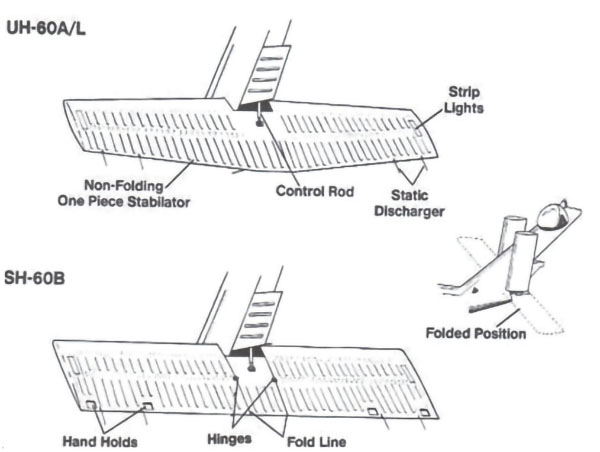
General Arrangement Drawing
Mission Systems
The Seahawk was developed to be the platform for the Navy’s Light Airborne Multi-Purpose System referred to as the LAMPS Mark III. This system consisted of acoustic sensors for detecting submarines and radar for detecting surface ships. It included equipment for data processing plus secure transmission of data back to the fleet. Its purpose was to search and clear the outer zone area to a distance of approximately 30 nautical miles ahead of an aircraft carrier battle group. The search radar system installed beneath the cockpit provided a picture of the surface threat situation as well as providing a standoff targeting capability for the battle group’s surface-to-surface missiles.
The SH-60B carried 25 sonobouys, along with a sonobouy data processing receiver, which are passive/active underwater acoustic devices that are ejected pneumatically from the left side. On the right side, above and behind the weapons pylon, was mounted a Magnetic Anomaly Detector used to detect the presence of a submarines by measuring the changes in the local magnetic field. A surface-search radar unit was mounted in the radome beneath the cockpit, capable of 360-degree search coverage. Other sensors included forward-looking infrared (FLIR) and electronic support measures (ESM). All of this equipment was networked into a central computer so that the information gathered by the sensors could be sent back to the ship by high-speed digital radio transmission>
When this LAMPs Mark III program started, the Navy adopted a new approach for managing the Seahawk’s weapons systems integration during the design and production phases. It became the overall prime contractor over both Sikorsky, who was the air vehicle contractor, and over IBM who was selected to integrate the ship and aircraft electronic systems. During the production program, Sikorsky flew relatively bare Seahawks from Stratford CT to IBM’s facility in Owego, NY where the mission equipment package was installed and tested. Completed Seahawks were then delivered to the Navy from the IBM facility that later became Lockheed Martin Systems Integration-Owego.
General Characteristics and Performance
The performance and specifications presented herein accurately describe this Sikorsky model at a point in time of its evolution. Some variation to these data can be expected as a result of engine power rating improvements and aircraft design changes. Please contact the Igor I. Sikorsky Historical Archives if your inquiry is about a specific configuration of this model and you desire to learn about its particular attributes.
- Main rotor diameter: 53.6 ft. (16.36 M); 4 blades, airfoil SC1095 and SC1094R8.
- Main rotor blade chord: 1.73 ft., tip swept aft 20 degrees; negative blade twist of 18 degrees
- Main rotor solidity: .083; main rotor tip speed: 725 fps.
- Main rotor flapping hinge offset of 15 in.
- Tail rotor diameter: 11.00 ft. (3.35 M); 4 blades; chord .81 ft., airfoil SC1095.
- Tail rotor solidity: .1875, tail rotor tip speed: 699 fps.
- Main gearbox rated power: 3400 hp. Input/output speeds: 20,900/258 rpm.
- Crew: Pilot, Airborne Tactical Officer (copilot), and Sensor Operator (SENSO)
- Capacity: 5 passengers in cabin or internal load of 4,100 lb., external load 6,000 lb. (2,722 Kg)
- Empty weight: 13,648 lbs. (6,189 Kg)
- Gross weight for ASW missions: 21,110lb. (9,575 Kg)
- Gross weight for ASST missions: 19,266 lb. (8,739 Kg)
- Maximum takeoff weight: 21,884 lb. (9,927 Kg)
- External cargo hook capacity: 6,000 lb.
- Engines: Two T700-GE-401C, 1,890 HP takeoff power each engine
- Dash speed at 5,000 ft. tropical day: 131 kt (243 km/hr.)
- Endurance: 3.5 to 6 hours
- Vertical Rate of Climb sea level 90 degrees F: 259 FPM (1.32 M/Sec)
- OEI Rate of Climb sea level 90 degrees F: 200 FPM (1.02 M/sec)
Production
The first production Seahawk flew in February 1983 and entered service in 1984 when the first squadron was formed. Production for the Navy ended in 1993 after 181 aircraft were delivered in accordance with the Navy’s plan to replace early Seahawks along with many other helicopter models by a new multi-purpose Seahawk, the MH-60R, as described below. SH-60B Seahawks were also produced for foreign governments including 16 for the Royal Australian Navy, 11 for the Greek Navy, 101 for the Japanese Maritime Defense Force, 21 for the Republic of China Navy, 12 of for the Spanish Navy, 6 for the Royal Thai Navy and 8 for the Turkish Navy. It should be noted these international sales reflect their status as of 2007 and could increase in both customers and quantities with time.
Related Models
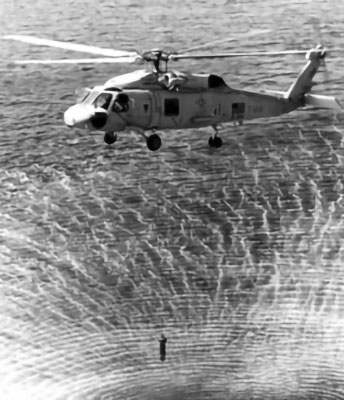
The AQS-13F active dipping sonar shown here replaced the SH-60B MAD and search radar. A gravity launcher holding six sonobouys replaced the pneumatic system. The SH-60B RAST system was also deleted as the SH-60F was intended to operate from carrier decks instead of from small vessels.
The Navy began development of a special version of the SH-60F in 1986 designed to provide combat strike rescue and special warfare support in all weather and in combat conditions. This version was designated as the HH-60H. It first flew in August 1988 and entered service in March 1989. Approximately 45 HH-60Hs have been deployed. As part of the Navy’s consolidation plan, this model was gradually replaced by the MH-60S, which entered service in 2002.
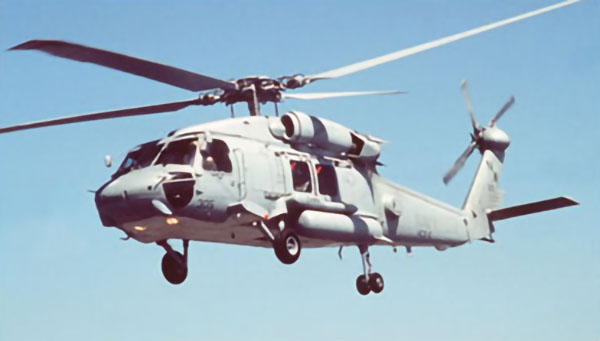
In 1986 the US Coast Guard began development of a new medium range search and rescue helicopter based on a rescue version of the SH-60F. This development produced the HH-60J Jayhawk whose mission was to fly out 300 miles, conduct search operations for one and a half hours, rescue up to six people and return to base. Forty-two Jayhawks were delivered to the Coast Guard between 1990 and 1996
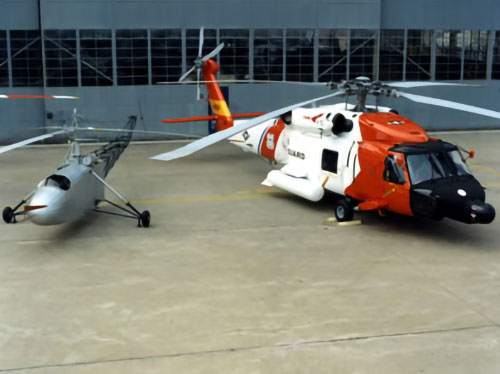
The USCG began converting its HH-60Js to MH-60Ts in January 2007. This avionics and capabilities upgrade is part of the USCG’s Integrated Deepwater System Program and will provide a glass cockpit, an enhanced electro-optic/infrared sensor system as well as a radar sensor system and airborne use of force capability. The airborne use of force package includes weapons for firing warning and disabling shots against surface vessels and armor to protect the aircrew from small arms fire. Three Jayhawks have been upgraded to MH-60Ts as of June 2009 and all 42 aircraft are scheduled to be upgraded by 2015.
Several key design features of the Black Hawk, unique among contemporary helicopters of that era, made this model especially well suited for use in the United States executive transport service. Chief among these features were its excellent survivability and performance characteristics described in some detail in the YUH-60A UTTAS model description found in this website. In addition, the Black Hawk’s designed-in capability to be rapidly prepared for air transport and then rapidly prepared for flight following long-range deployment made it especially attractive for the executive transport mission. All other helicopters employed in this critical mission required extensive, time-consuming disassembly to fit within USAF fixed wing transport aircraft of the time. The Black Hawk was designed to avoid this lost time.
Combining the Black Hawk’s airframe with the Seahawk’s uprated propulsion, transmission and flight control systems provided a configuration that won support from the government leading to a development contract awarded to Sikorsky in 1986. Many of the proven UH-60A ballistic and crashworthiness features were retained including the hover infrared suppression system for the engines. In addition, special design features were incorporated to provide hardening against electromagnetic pulse threats.
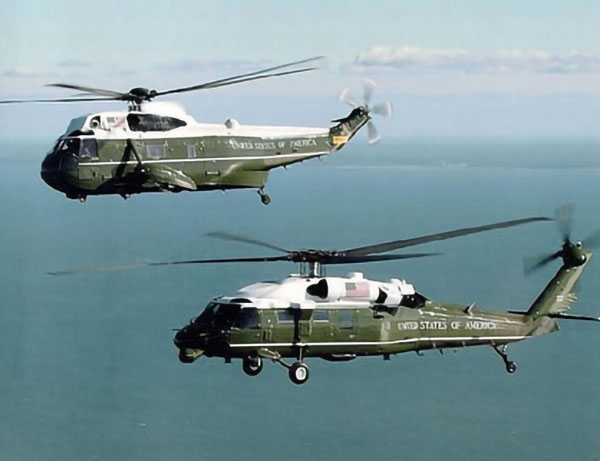
The VH-60N entered service in 1988 and nine units were delivered. Its interior was configured with an executive style interior including extensive soundproofing. Many upgrades to the avionics system were installed including secure worldwide communications capability controlled by a radio operator seated in the forward portion of the cabin.
During the 1990s, the Navy created a master plan to consolidate its requirements into two basic helicopter configurations. It began to phase out seven existing different helicopters replacing them with two new Sikorsky models: the MH-60S and the MH-60R. The MH-60S first flew in January 2000 and entered fleet service in 2002. The MH-60R flew in July 2001 and entered service in 2005.
Additional Information Sources
Additional information about Black Hawk and Seahawk related models can be accessed on this website.
Information about the Black Hawk, Seahawk and their derivative and international models can be found in the book entitled: “Black Hawk, the Story of a World Class Helicopter” published by the American Institute of Aeronautic and Astronautics in 2007 and written by Ray D. Leoni. ISBN-13:987-1-56347-918-2.
by Ray D Leoni
Related Articles
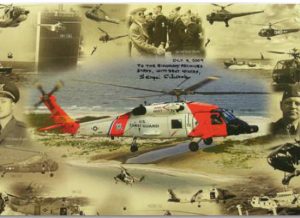
Sikorsky Serves the Coast Guard
A flight demonstration of Igor Sikorsky’s VS-300A helicopter at Bridgeport, Connecticut in April 1942 started an air-sea rescue revolution in the U.S. Coast Guard.
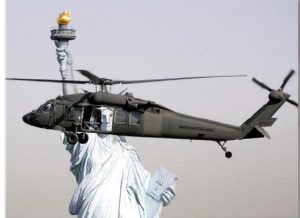
The Sikorsky Black Hawk in U.S. Military Service
When Black Hawk program manager Colonel Richard Kenyon received keys to Sikorsky’s first production UH-60A on October 31, 1978, the U.S. Army received the powerful, hardened assault helicopter it wanted.
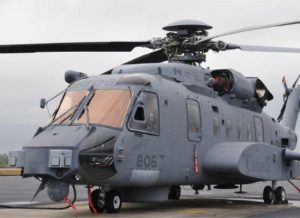
Sikorsky’s Sub Hunters
Today’s MH-60R gives the U.S. Navy the world’s most advanced ASW helicopter. However, the potential of the helicopter in ASW was recognized even before the Navy and Coast Guard flew their first Sikorsky R-4s in World War II.

